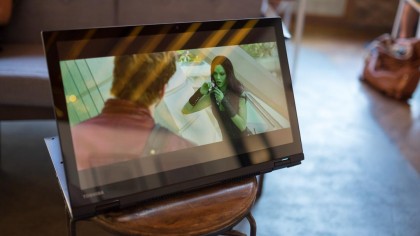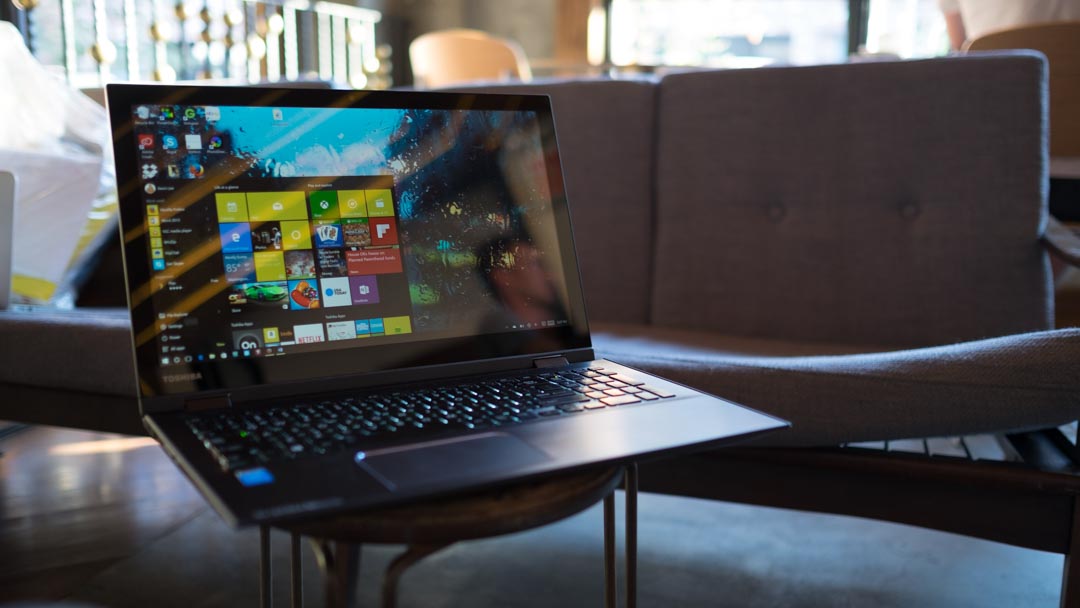Why you can trust TechRadar
While the Toshiba Satellite Radius 15 only comes with integrated graphics, the Intel Core i7 chip barely broke a sweat while driving the 4K display. The laptop ran smoothly at its Ultra HD resolution, even under the massive load of running two tab-filled internet browsers simultaneously, chat programs, streaming tunes on Groove Music and a small window of YouTube videos in the background.
The 4K Radius 15 a solid performer – just so long as you're not playing any games. Unsurprisingly, Metal Gear V: The Phantom Pain brought this machine to its knees, running at 20 fps even after I brought the graphical settings to their lowest level and tuning the resolution down to 720p.
Rocket League also proved to be almost too much for the Radius 15's integrated graphics. Even with the lowest possible resolution setting and toning down the graphical options, the game was only able to run at a saddening 20fps. It also doesn't help that Rocket League looks like a terribly pixelated PlayStation game on this extremely sharp display.

Benchmarks
Here's how the Toshiba Satellite Radius 15 performed in our suite of benchmark tests:
- 3DMark: Cloud Gate: 5,187; Sky Diver: 2,452; Fire Strike: 615
- Cinebench CPU: 274 points; Graphics: 27 fps
- GeekBench: 2,701 (single-core); 5,734 (multi-core)
- PCMark 8 (Home Test): 2,179 points
- PCMark 8 Battery Life: 2 hours and 45 minutes
Unsurprisingly, the Asus ZenBook Pro UX501 absolutely decimated the Radius 15 in every graphical benchmark test. Case and point: the UX501 put up a Fire Strike score of 3,669 points, almost six times the 615-point score the Toshiba laptop was able to produce.
While it might seem like the Radius 15's 3DMark scores puts it on par with an Ultrabook, this is largely because of its 4K resolution display. Driving that many pixels is a huge tax on the processor and, unlike the Radius 15, the UX501 has an extra helping hand by way of its discrete graphics card.
Driving 3,840 x 2,160 pixels naturally drags on processor performance, and so it's fitting to see that the Radius 15 also has a fairly underwhelming PCMark 8 score of 2,179 points. That said, the Toshiba UHD laptop's performance isn't lagging behind too badly compared to the 2,239 point score put up by the Dell Inspiron 15 7000, which is running at a much less grueling 1,080p resolution.
Sign up to the TechRadar Pro newsletter to get all the top news, opinion, features and guidance your business needs to succeed!

Life with a giant convertible
Convertibles any larger than 13 inches are hard to justify because of their unwieldy and large screens. By this measure, holding up a 15-inch tablet should be ridiculous, and you would be right to think that. However, in my own time using the Radius 15, I found it's 2-in-1 features to make a lot of sense.
While laying back on the couch, I could still use the laptop when I laid the screen at a 180-degree angle, thanks to its hybrid design. While the notebook's large form factor doesn't make it a practical handheld tablet, it makes a lot of sense when you have the display propped up in presentation mode or using the device as a large touchscreen on your lap.

Quartered battery life
Unfortunately, one of the Toshiba Satellite Radius 15's biggest shortcomings is battery life. After running down this notebook multiple times, I found that the longest run time you can get is roughly four hours, and that's with the daintiest workload of opening five Firefox tabs and editing a Microsoft document, all at less than 50% screen brightness and turning off the keyboard backlight.
Even with our lightweight movie test, the Radius 15 lasted for a paltry 3 hours and 15 minutes. Our other PCMark 8 battery test yielded an even shorter 2 hours and 45 minutes of run time. By comparison, the Asus UX501 ran for 3 hours and 20 minutes, while the Inspiron 15 7000's ran for an additional 20 minutes longer.
As for why the Radius 15 has a shorter battery life, we can look at the laptop's poor benchmark scores. They allude to the processor being stressed regularly to drive the 4K display, and as a result, drawing more power. In short, you shouldn't expect to use the Radius 15 for an extended period away from the power plug.

Bundled software
Users spinning up their system for the first time will find their program list already cluttered with non-essential applications. All the usual suspects are here, including Candy Crush Saga, iHeartRadio and shortcuts leading to TripAdvisor and Booking.com's respective websites.
The only real exception is the bundled Chroma Tune program, which lets you switch to multiple predefined color grading schemes. Some of these screen presets are more green, while others are warmer or cooler. They should come in handy when you're trying to accurately edit colors in Lightroom and other programs.
Kevin Lee was a former computing reporter at TechRadar. Kevin is now the SEO Updates Editor at IGN based in New York. He handles all of the best of tech buying guides while also dipping his hand in the entertainment and games evergreen content. Kevin has over eight years of experience in the tech and games publications with previous bylines at Polygon, PC World, and more. Outside of work, Kevin is major movie buff of cult and bad films. He also regularly plays flight & space sim and racing games. IRL he's a fan of archery, axe throwing, and board games.

